
Apr 3
/
Alef Dias
Grains, Oilseeds and Livestock Weekly Report - 2024 04 03
Back to main blog page
Prospective Plantings report adds bullish risks for US crops
- The USDA's Planting Intentions Report - released last Thursday - is one of the most important reports of the year. It gives the total area of the main crops that American farmers intend to plant in the next cycle (24/25).
- This year, the report confirmed market expectations of a shift to soybeans. However, the cut in corn acreage was much larger than expected. Consequently, the report showed that US farmers intend to reduce the total planted area by more than 3M ac.
- Additionally, area for both crops was smaller than the first estimates released at the USDA's Agriculture Outlook Forum in February, which means that stocks will be tighter in 24/25 than initially forecast - although looser than in the current cycle.
- For corn, the fact that the USDA usually overestimates yield estimates at the beginning of the season brings an additional upside risk.
Introduction
USDA's Planting Intentions Report - released last Thursday - is one of the most important reports of the year. It gives the total area of the main crops that American farmers intend to plant in the next cycle (24/25). As such, it sets the tone for the supply side of the balance sheets throughout the year.
In this report, we'll look at the main highlights of the report that impact the outlook for the American balances for the next marketing cycle.
Fig. 1: US Planted Area Summary (M ha)
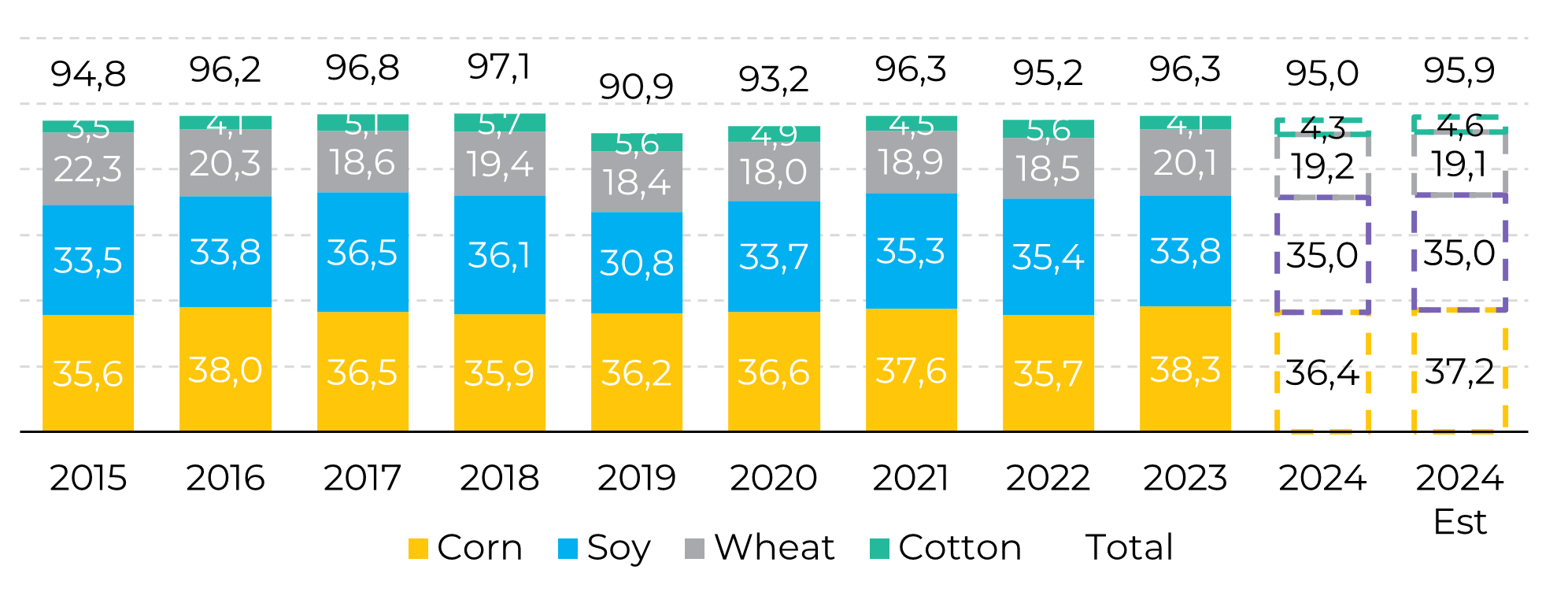
Source: hEDGEpoint, Bloomberg, USDA.
Report confirms more soy-oriented cycle, but figures are lower than initial estimates
This year, the Planting Intentions Report confirmed the market's expectation of a shift towards soybeans in American farmers' planting decisions. Although the market was already expecting this shift, the cut in corn acreage (-4.6M ac compared to 2023) was much larger than the market's average estimate (-2.8M ac).
Corn acres are lower across the Corn Belt, with marginal increases in the western part of the country. Corn acres were down from the previous year in 38 of the 48 states covered by the report.
As a result, the report showed that US farmers intend to reduce the total planted area by more than 3M ac - a much larger cut due to corn planting. This shows that farmers were more sensitive to the low price scenario.
Fig. 2: US Corn - Supply and Demand (M ton)
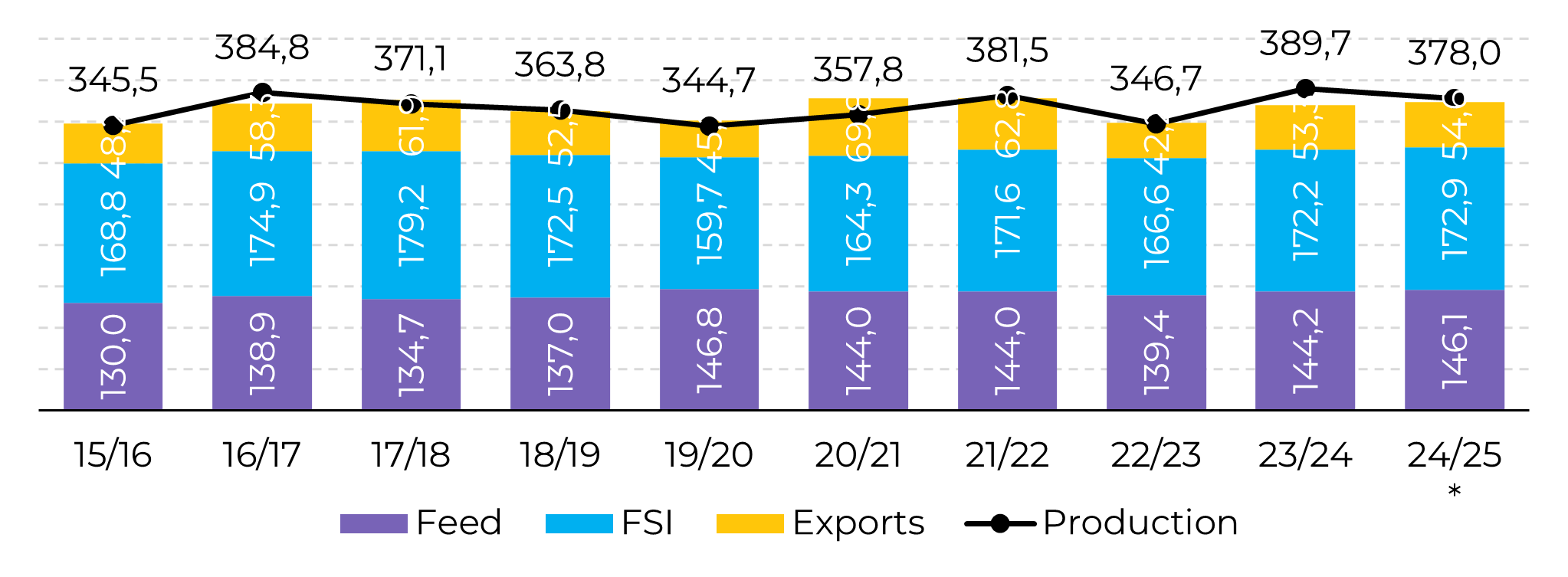
Source: USDA. *Considering the area estimate from the Planting Intentions and other estimates from the Outlook Forum.
Fig. 3: US Corn - Stocks and Stocks/Use (M ton, %)
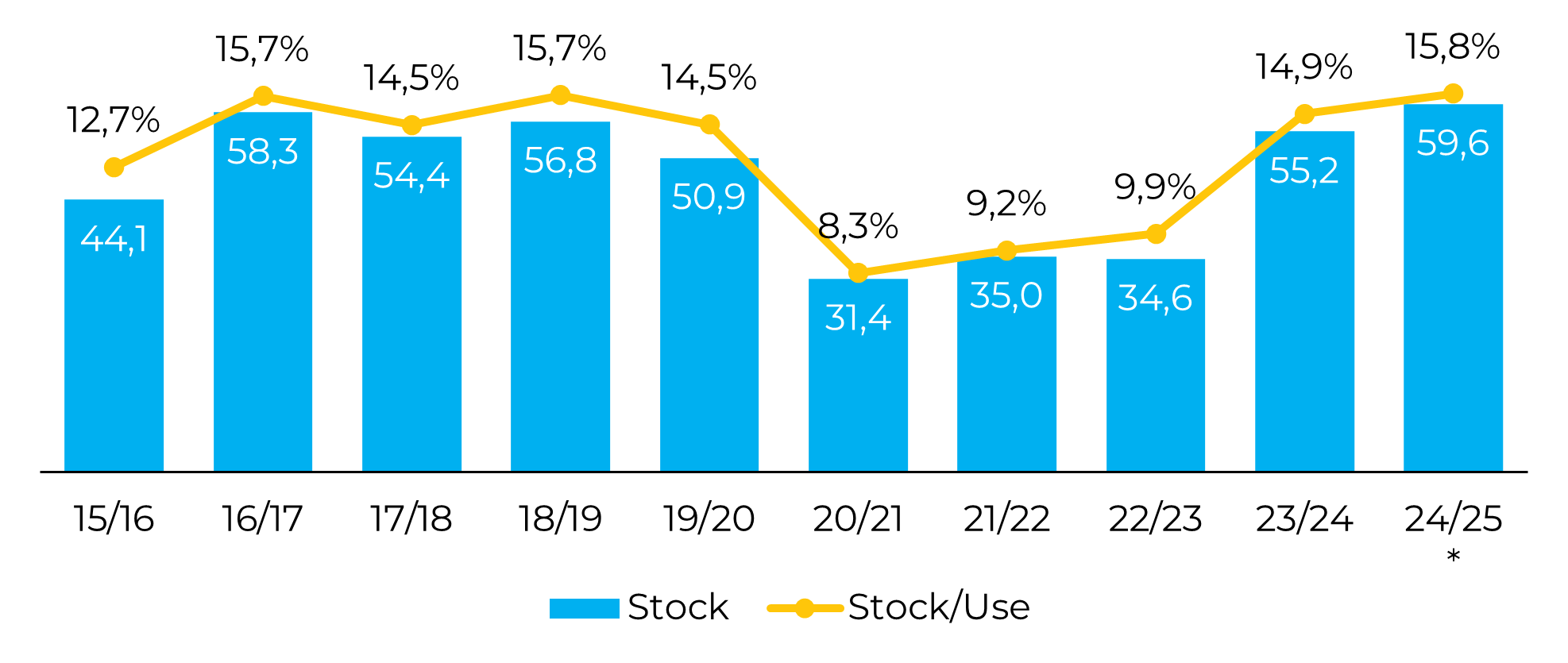
Source: USDA. *Considering the area estimate from the Planting Intentions and other estimates from the Outlook Forum.
In soybeans, the USDA estimated acreage in 2024 at 86.15M ac, almost identical to the average estimate of 86.309M ac (range 84.3 to 88.0). Soybean acres in 2023/24 totaled 83.6 million. If realized, the 2024 planting would represent an increase of 2.91M ac, or 3.5% over the previous year. This would also mark the fifth largest soybean planted area on record.
Soybean area is expected to increase in most states. Of the 29 main soybean producing states, 22 are expected to see an increase in acres from last year.
Soybean area is expected to increase in most states. Of the 29 main soybean producing states, 22 are expected to see an increase in acres from last year.
In addition, the areas of both crops were lower than the initial estimates released at the USDA's Agriculture Outlook Forum in February. Considering the Planting Intentions, the US should still have looser stocks in both soybeans and corn in 24/25, but not as much as estimated in February.
S
Fig. 4: US Soybeans - Supply and Demand (M ton)

Source: USDA. *Considering the area estimate from the Planting Intentions and other estimates from the Outlook Forum.
Fig. 5: US Soybeans - Stocks and Stocks/Use (M ton, %)
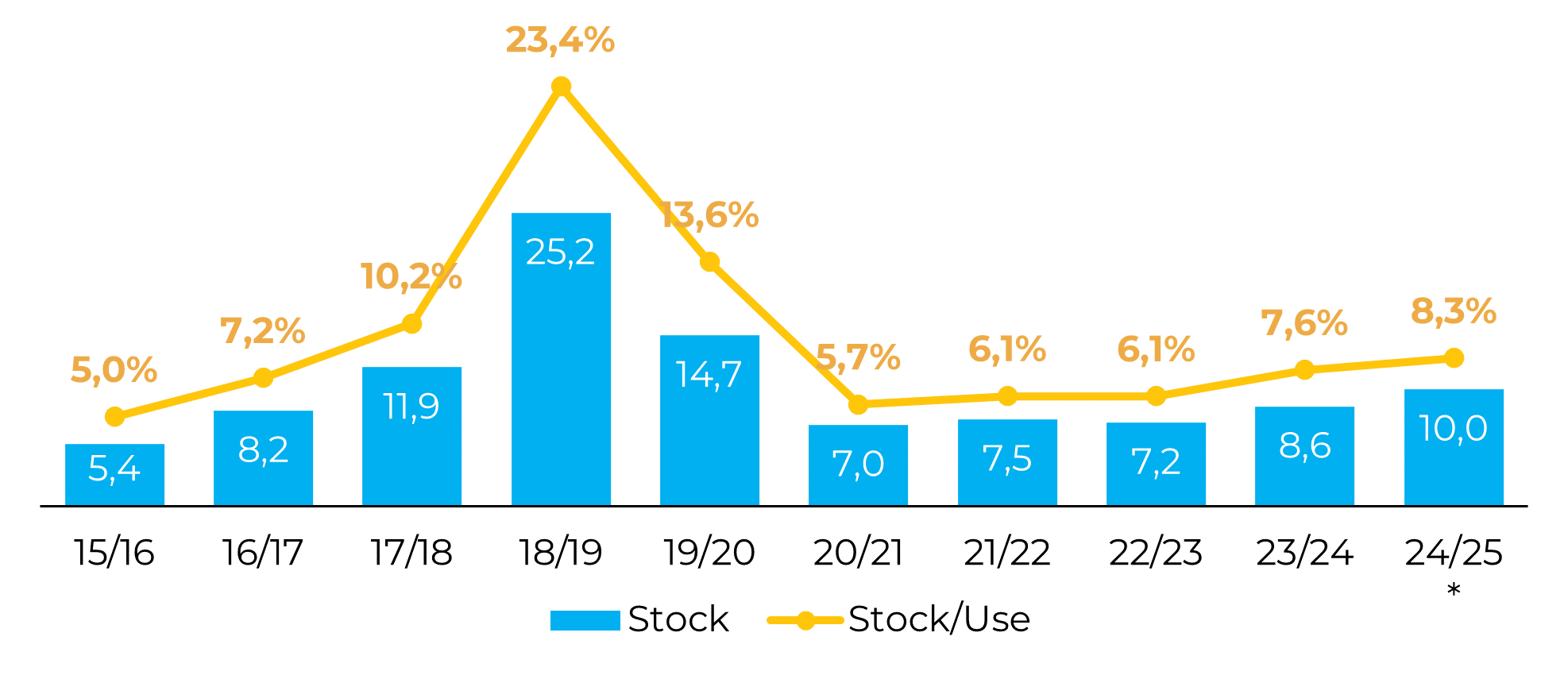
Source: USDA. *Considering the area estimate from the Planting Intentions and other estimates from the Outlook Forum.
It's interesting to note that, especially for corn, the USDA tends to overestimate yields in February, so a further tightening of the corn balance has a considerable chance of happening.
As a result, the US weather is likely to become increasingly important in the coming months, as corn planting has already begun in some states and soybean planting is expected to start in the coming weeks.
Fig. 6: US Corn Yield - Final versus Ag Outlook (bu/ac)
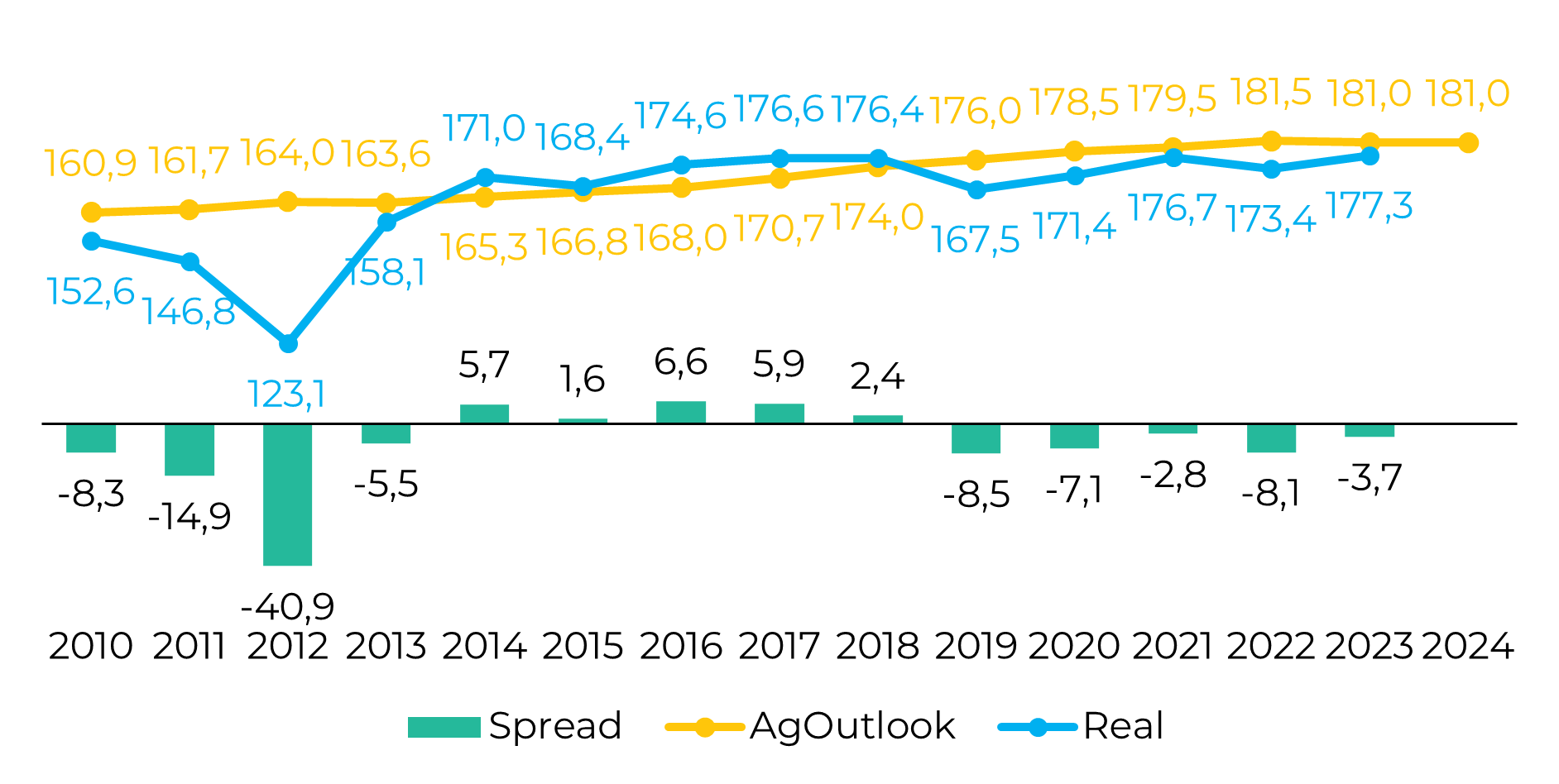
Source: hEDGEpoint, USDA
In summary
This year's Planting Intention Report confirmed the market's expectation of a shift towards soybeans in the planting decision of American farmers.
Although the market was already expecting this change, the cut in corn acreage was much larger than expected. Consequently, the report showed that US farmers intend to reduce the total planted area by more than 3M ac.
In addition, the areas of both crops were smaller than the first estimates released in February. The US should still have looser stocks in both soybeans and corn on 2/24/25, but not as much as estimated in February. For corn, the fact that the USDA usually overestimates yield at the beginning of the season brings an additional bullish risk.
Weekly Report — Grains and Oilseeds
Written by Alef Dias
alef.dias@hedgepointglobal.com
Reviewed by Laleska Moda
laleska.moda@hedgepointglobal.com
laleska.moda@hedgepointglobal.com
www.hedgepointglobal.com
Disclaimer
This document has been prepared by hEDGEpoint Global Markets LLC and its affiliates ("HPGM") exclusively for informational and instructional purposes, without the purpose of creating obligations or commitments with third parties, and is not intended to promote an offer, or solicitation of an offer, to sell or buy any securities or investment products. HPGM and its associates expressly disclaim any use of the information contained herein that may result in direct or indirect damage of any kind. If you have any questions that are not resolved in the first instance of contact with the client (client.services@hedgepointglobal.com), please contact our internal ombudsman channel (ouvidoria@hedgepointglobal.com) or 0800-878-8408 (for clients in Brazil only).
Contact us
hedgepointhub.support@hedgepointglobal.com
ouvidoria@hedgepointglobal.com
Funchal Street, 418, 18º floor - Vila Olímpia São Paulo, SP, Brasil
Check our general terms and important notices.
This page has been prepared by Hedgepoint Schweiz AG and its affiliates (“Hedgepoint”) solely for informational and instructional purposes, without the purpose of instituting obligations or commitments to third parties, nor is it intended to promote an offer, or solicitation of an offer of sale or purchase relating to any securities, commodities interests or investment products. Hedgepoint and its associates expressly disclaim any use of the information contained herein that directly or indirectly result in damages or damages of any kind. Information is obtained from sources which we believe to be reliable, but we do not warrant or guarantee the timeliness or accuracy of this information. The trading of commodities interests such as futures, options, and swaps involves substantial risk of loss and may not be suitable for all investors. You should carefully consider wither such trading is suitable for you in light of your financial condition. Past performance is not necessarily indicative of future results. Customers should rely on their own independent judgement and/or advisors before entering in any transaction.Hedgepoint does not provide legal, tax or accounting advice and you are responsible for seeking any such advice separately.Hedgepoint Schweiz AG is organized, incorporated, and existing under the laws of Switzerland, is filiated to ARIF, the Association Romande des Intermédiaires Financiers, which is a FINMA-authorized Self-Regulatory Organization. Hedgepoint Commodities LLC is organized, incorporated, and existing under the laws of the USA, and is authorized and regulated by the Commodity Futures Trading Commission (CFTC) and a member of the National Futures Association (NFA) to act as an Introducing Broker and Commodity Trading Advisor. HedgePoint Global Markets Limited is Regulated by the Dubai Financial Services Authority. The content is directed at Professional Clients and not Retail Clients. Hedgepoint Global Markets PTE. Ltd is organized, incorporated, and existing under the laws of Singapore, exempted from obtaining a financial services license as per the Second Schedule of the Securities and Futures (Licensing and Conduct of Business) Act, by the Monetary Authority of Singapore (MAS). Hedgepoint Global Markets DTVM Ltda. is authorized and regulated in Brazil by the Central Bank of Brazil (BCB) and the Brazilian Securities Commission (CVM). Hedgepoint Serviços Ltda. is organized, incorporated, and existing under the laws of Brazil. Hedgepoint Global Markets S.A. is organized, incorporated, and existing under the laws of Uruguay. In case of questions not resolved by the first instance of customer contact (client.services@Hedgepointglobal.com), please contact internal ombudsman channel (ombudsman@hedgepointglobal.com – global or ouvidoria@hedgepointglobal.com – Brazil only) or call 0800-8788408 (Brazil only).Integrity, ethics, and transparency are values that guide our culture. To further strengthen our practices, Hedgepoint has a whistleblower channel for employees and third-parties by e-mail ethicline@hedgepointglobal.com or forms Ethic Line – Hedgepoint Global Markets.Security note: All contacts with customers and partners are conducted exclusively through our domain @hedgepointglobal.com. Do not accept any information, bills, statements or requests from different domains and pay special attention to any variations in letters or spelling, as they may indicate a fraudulent situation.“HedgePoint” and the “HedgePoint” logo are marks for the exclusive use of HedgePoint and/or its affiliates. Use or reproduction is prohibited, unless expressly authorized by HedgePoint. Furthermore, the use of any other marks in this document has been authorized for identification purposes only. It does not, therefore, imply any rights of HedgePoint in these marks or imply endorsement, association or seal by the owners of these marks with HedgePoint or its affiliates.
We have updated our Terms & Conditions to reflect improvements to our platform, data handling practices, and the overall experience we provide to our clients.
To continue using the Hedgepoint HUB, please review and accept the updated terms.

